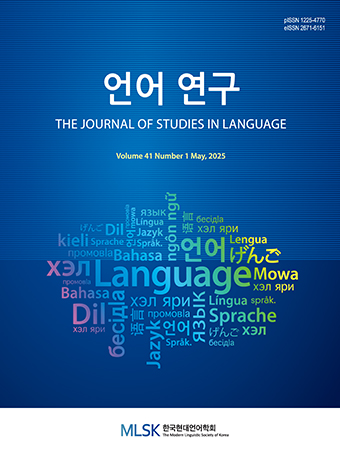Research Article
Abstract
References
Information
This paper analyzes the various sizes of Korean lexicons (39 lexicons ranging from 1,592 words to 101,804 words) in terms of phonological word-similarity in the framework of network theory. 101,804 words are selected to make these lexicons from Kang and Kim(2009). The phonological neighborhood network for each lexicon is constructed. Its giant component (GC), average shortest path length (ASPL), average clustering coefficient (ACC), and assortative mixing by degree (AMD) are measured. The results are compared with those of several languages in previous studies. It is shown that the Korean phonological neighborhood network exhibits some language-universal properties. It satisfies the requirements for being a small-world network. However, language-particular properties are also found in the Korean phonological neighborhood network. The GC size is relatively larger than those in the other languages. In the value-curves of GC size, ASPL, and AMD based on the lexicon size, Korean exhibits the rise and fall shapes, which are not observed in the other languages.
- 강범모, 김흥규. 2009. 『한국어 사용 빈도』(CD 포함). 서울: 한국문화사.
- 국립국어원. 2020. 『표준국어대사전』(온라인 판 , https://stdict.korean.go.kr). 2020년 8월 현재. 서울: 국립국어원.
- 김미란, 최재웅, 홍정하. 2014. 한국어 초·중성 결합의 분포적 특성 및 모음의 군집분석 연구. 『음성·음운·형태론 연구』20, 23-49.
- 김한샘. 2005.『현대 국어 사용 빈도 조사 2』. 서울: 국립국어원.
- 남성현, 김선회. 2018. 영어와 한국어 음운이웃 네트워크의 정량적 분석.『음성·음운·형태론 연구』24, 3-28. 10.17959/sppm.2018.24.1.3
- 신지영, 차재은. 2013. 『우리말 소리의 체계: 국어 음운론 연구의 기초를 위하여』. 서울: 한국문화사.
- Arbesman, S., S. H. Strogatz, and M. S. Vitevitch. 2010. The Structure of Phonological Networks across Multiple Languages. International Journal of Bifurcation and Chaos 20, 679-685. 10.1142/S021812741002596X
- Fromkin, V., R. Rodman, and N. Hyams. 2014. An Introduction to Language. Boston, MA: Wadsworth.
- Goulden, R., P. Nation, and J. Read. 1990. How Large Can a Receptive Vocabulary Be? Applied Linguistics 11, 341-363. 10.1093/applin/11.4.341
- Gruenenfelder, T. M. and D. D. Pisoni. 2009. The Lexical Restructuring Hypothesis and Graph Theoretic Analyses of Networks Based on Random Lexicon. Journal of Speech, Language and Hearing Research 52, 596-609. 10.1044/1092-4388(2009/08-0004)
- Holliday, J. J., R. Turnbull, and J. Eychenne. 2017. K-Span: A Lexical Database of Korean Surface Phonetic Forms and Phonological Neighborhood Density Statistics. Behavioral Research Models 49, 1930-1950. 10.3758/s13428-016-0836-8 28155186
- Klatt, D. H. 1987. Review of Text‐to‐speech Conversion for English. The Journal of the Acoustical Society of America 82, 737-793. 10.1121/1.395275 2958525
- Nam, S. 2018. Phonotactic Difference by Lexical Strata: A Case from Korean Phonological Neighbourhood Network Analysis [Conference presentation]. ConSOLE 2018, University College London, London, UK.
- Luce, P. A. and D. B. Pisoni. 1998. Recognizing Spoken Words: The Neighborhood Activation Model. Ear and Hearing 19, 1-36. 10.1097/00003446-199802000-00001 9504270 PMC3467695
- Nation, P. 2006. How Large a Vocabulary Is Needed for Reading and Listening? The Canadian Modern Language Review 63, 59-82. 10.3138/cmlr.63.1.59
- Newman, M. 2002. Assortative Mixing in Networks. Physical Review Letters 89, 208701. 10.1103/PhysRevLett.89.208701 12443515
- Newman, M. 2018. Networks. Oxford: Oxford University Press. 10.1093/oso/9780198805090.001.0001 PMC6686830
- Shin, J., J. Kiaer, and J. Cha. 2012. The Sounds of Korean. Cambridge: Cambridge University Press. 10.1017/CBO9781139342858
- Shoemark, P., S. Goldwater, J. Kirby, and R. Sarkar. 2016. Towards Robust Cross-linguistic Comparison of Phonological Networks. Proceedings of the 14th Annual SIGMORPHON Workshop on Computational Research in Phonetics, Phonology, and Morphology, 110-120. 10.18653/v1/W16-2018
- Sohn, H.-M. 1999. The Korean Language. Oxford: Oxford University Press.
- Turnbull, R. and S. Peperkamp. 2017. What Governs a Language’s Lexicon? Determining the Organizing Principles of Phonological Neighbourhood Networks. In H. Cherifi, S. Gaito, W. Quattrociocchi, and A. Sala (eds.), Complex Networks and their Applications V: Proceedings of the 5th International Workshop on Complex Networks and their Applications. Cham, Switzerland: Springer, 83-94. 10.1007/978-3-319-50901-3_7
- Vitevitch, M. S.2008. What Can Graph Theory Tell Us about Word Learning and Lexical Retrieval? Journal of Speech, Language, and Hearing Research 51, 408-422. 10.1044/1092-4388(2008/030)
- Watts, D. J. 2004. Small Worlds: The Dynamics of Networks between Order and Randomness. Princeton, NJ: Princeton University Press. 10.1038/30918 9623998
- Watts, D. J. and S. H. Strogatz. 1998. Collective Dynamics of “Small-world” Networks. Nature 393, 440-442.
- 국립국어원. 2020. “우리말샘” https://opendic.korean.go.kr/main.
- 전희원. 2016. KoNLP: Korean NLP package (Version 0.80.1) https://cran.r-project.org/src/contrib/Archive/KoNLP/.
- Csárdi, G. 2019. Package ‘igraph’. https://igraph.org/.
- Mrvar A. and V. Batagelj. 1996. Networks/Pajek: Program for Lrge Network Analysis (Version 5.09) [Computer Program]. http://mrvar.fdv.uni-lj.si/pajek.
- R Development Core Team. 2019. R: A Language and Environment for Statistical Computing (Version 3.6.0). http://www.r-project.org.
- Publisher :The Modern Linguistic Society of Korea
- Publisher(Ko) :한국현대언어학회
- Journal Title :The Journal of Studies in Language
- Journal Title(Ko) :언어연구
- Volume : 36
- No :3
- Pages :263-284
- DOI :https://doi.org/10.18627/jslg.36.3.202011.263




 The Journal of Studies in Language
The Journal of Studies in Language






